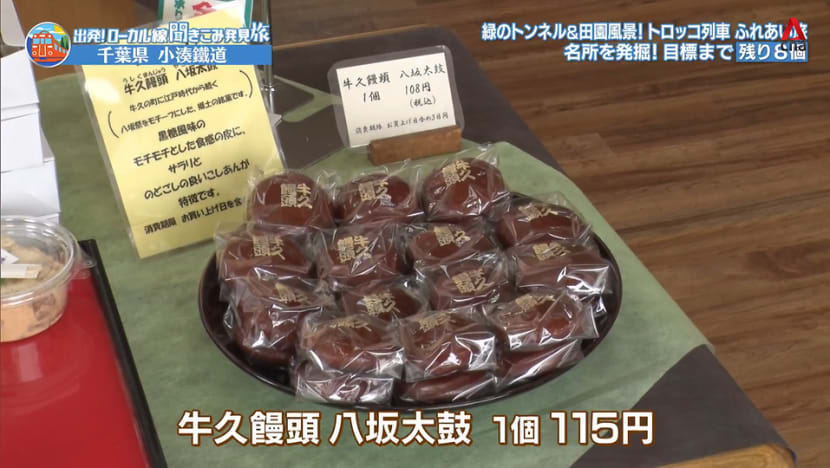Road Trip On Kominato Tetsudo - Part 1
A dam which is a popular summer attraction, a traditional Japanese confectionery inspired by a local festival and a valley known for its "black water" hot spring are among this week's highlights.

This week, our two-day journey takes place on the Kominato Line in Chiba Prefecture. The local line runs through the rich greenery of Chiba, including the scenic Yoro Valley. It connects the coast of Tokyo Bay to the inland areas of Boso Peninsula. It was established in 1925 and its steam locomotive trains were replaced by diesel trains around 1960. The railway line has 18 stations and covers a total distance of 39.1km.
We start from Goi Station in Ichihara City and buy one-day passes which allow us to alight at any station along the line. We then board a one-car train at 9.10am and alight at Amaariki Station, two stops away from Goi. This station is named after Ama Village and Ariki Castle that used to be in the area. A resident we speak to suggests we visit the Yamakura Dam, where the locals would go to relax. It is usually crowded during the summer, with kids playing and people jogging and walking around the dam.
It takes us about 20 minutes to walk to Yamakura Dam, which was completed in 1964. It takes water from the Yoro River which flows nearby. It provides a stable supply of water to the Keio industrial area on the coast.
We go back to the station and a passenger tells us about a ramen shop called Dabo House near Kofudai Station. Its plum, salt and butter ramen is popular. We take the train to Kofudai Station, where a local tells us that trolley trains are a popular attraction of the Kominato Line. These trains run from Kazusa-Ushiku Station. From Kofudai Station, we walk for 10 minutes to Dabo House, which originally opened as a cafe in 1985. We order the plum and salt ramen with roasted pork. The ramen soup includes chicken bones, shaved bonito and dried sardines. The ramen is topped with thick pork slices and sweet Nanko plums. This ramen won the top prize at the Chiba Prefecture Ramen Championship.
Dabo House is crowded with locals, one of whom recommends we try the area’s famous Ushiku Manju. It can be found at confectionery shop Azumado near Kazusa-Ushiku Station. We then catch the 12.30pm train and go to Kazusa-Ushiku. We want to ride on the trolley train recommended to us earlier. However, there are only trolley trains per day on weekdays and the last one for the day has already departed.
We then drop by a store selling stationery and cosmetics to ask for directions to Azumado. We are told the store is located along the national road. After walking for about 10 minutes, we reach Azumado. Established in 1897, it sells both Japanese and Western confectionery. The owner tells us that its most popular product, Ushiku Manju, was inspired by the town’s famous Yasaka Festival. It is fluffy and the skin is made with kuzu starch and brown sugar, creating a unique chewy texture. It complements the smooth sweet bean paste well. Up to 2,000 pieces are sold on some days.
We also learn that Kazusa-Tsurumai Station has been named one of the 100 best stations in the Kanto region. The small, unmanned station building in the countryside has an old-fashioned and rustic vibe. Another place recommended to us is the Yasaka Shrine. We walk to the shrine from Azumado. The shrine was built more than 150 years ago. The same deity as the main Yasaka Shrine in Kyoto is worshipped here. Every year in the summer, the Ushiku Yasaka Festival is held here. It features floats from a few towns, the beating of drums and participants dancing to the Ushiku Bayashi song, which is the city’s Intangible Cultural Property.
After this, we take the 3.15pm train from Kazusa-Ushiku Station and go to Kazusa-Tsurumai, two stations away. The old-fashioned and nostalgic station building, established in 1925, has Taisho Roman-style tiles on the roof. Many TV dramas and films have been shot in this station, which has also been registered as a Tangible Cultural Property.
We next travel on the 4.10pm train to Takataki Station, which is about five minutes away from Kazusa-Tsurumai. We start looking for accommodation and speak to Mr Watanabe at a gas station nearby. He suggests we stay at a guest house called Sakaya. It is located in the hot spring village of Yoro Valley, known for its “black water” hot spring which is rich in iron. We manage to book two rooms and a staff from Sakaya picks us up. The car ride to the guest house takes 20 minutes.
Sakaya, established in 1972, is a cosy family-run guest house. It has eight-tatami mat Japanese-style rooms. For dinner, we are served an array of dishes such as pickled vegetables, croaker fish from Kisarazu, homegrown seasonal vegetables and deep-fried aubergines. We end the day by soaking in the refreshing “black water” hot spring, a speciality of Yoro Valley. The smooth and thick water is believed to be good for one’s skin and it also helps to relieve fatigue.
Tips:
1) The Yamakura Dam is a popular summer spot among the locals
2) Yoro Valley is known for its “black water” hot spring












